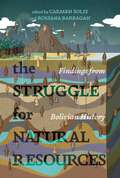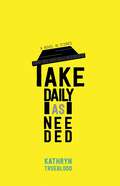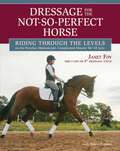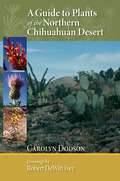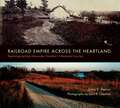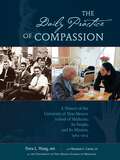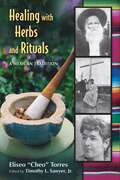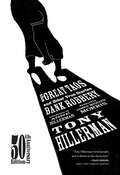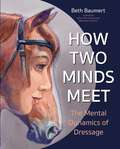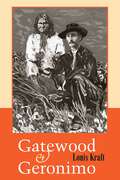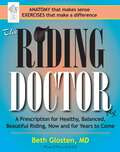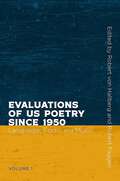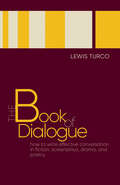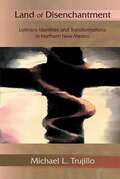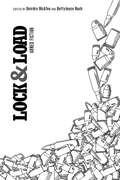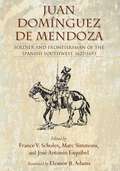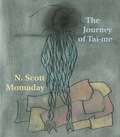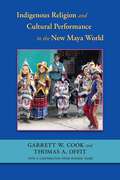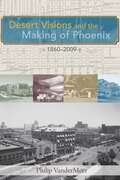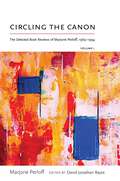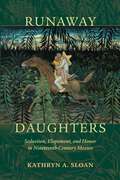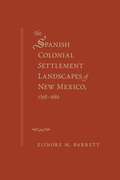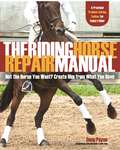- Table View
- List View
The Struggle for Natural Resources: Findings from Bolivian History (Diálogos Series)
by Carmen Soliz and Rossana BarragánThe Struggle for Natural Resources traces the troubled history of Bolivia's land and commodity disputes across five centuries, combining local, regional, national, and transnational scales. Enriched by the extractivism and commodity frontiers approaches to world history, the book treats Bolivia's political struggles over natural resources as long-term processes that outlast immediate political events. Exploration of the Bolivian case invites dialogue and comparison with other parts of the world, particularly regions and countries of the so-called Global South.The book begins by examining three Bolivian resources at the center of political dispute since the early colonial period, namely land, water, and minerals. Carmen Soliz, Rossana Barragán, and Sarah Hines show that, as in the colonial and early republican past, these resources have remained the focus of political contention to the present day. Until the end of the nineteenth century, Bolivia's battle over natural resources was primarily concentrated in the highlands and inter-Andean valleys. Beginning in the 1860s, the bicycle and soon the automobile industries triggered demand for natural rubber found in the heart of the Amazon. José Orsag analyzes the impact of this extractive economy at the turn of the twentieth century. The book concludes by examining two resources that are central to understanding the last century of Bolivia's history. Kevin Young examines the fraught business of hydrocarbons, and Thomas Grisaffi analyzes the coca/cocaine circuit. Each chapter studies the social dynamics and political conflicts that shaped the processes of extraction, exchange, and ownership of each of these resources
New Mexico Water and the Environment in 2050
by Laura Paskus Adrian OglesbyThe land, water, and air that make New Mexico a Land of Enchantment are facing increasing threats due to drought, climate change, and declining environmental quality protections. In this E-short edition from New Mexico 2050, noted environmental journalist Laura Paskus and Adrian Oglesby, a water law and water management expert, demonstrate how, in the face of such challenges, citizens can preserve and enrich New Mexico&’s natural resources.
Take Daily as Needed: A Novel in Stories
by Kathryn TruebloodMaeve Beaufort&’s family is messy and complicated, rife with competing demands, difficult compromises, and on-the-spot judgment calls. She is the single mother of Noelle, who has anaphylactic reactions to nuts, and Norm, a nonconformist child whom everyone wants to diagnose. Her father is spending his retirement on high-ticket items he doesn&’t need, her children&’s teachers are suggesting medication, and her mood-swinging mother is threatening to move in. Newly diagnosed herself with Crohn&’s disease, Maeve feels as though she is failing herself, her parents, and her children. But with spirit and determination—and a healthy dose of survival humor—she gives it her best go. Anyone who has ever felt overwhelmed, underappreciated, underpaid, and underwater will find a kindred spirit in Maeve.
Dressage for the Not-So-Perfect Horse
by Janet FoyA 5* dressage judge's practical ways to learn to love your horse's idiosyncrasies and turn weaknesses into strengths.Thousands of riders pursue the sport of dressage across the globe, and the majority do so on a budget and with the horse they already have, or quite simply, the one they can afford. This means riders daily face the challenge of mastering one of the world's most esteemed equestrian pursuits on horses that may not be bred specifically for the task, or even if they have been, may not be top prospects for any number of reasons—behavior quirks, conformational impediments, age or soundness—you name it.International dressage judge, clinician, and riding coach Janet Foy has ridden many different horses in the course of her riding and horse training career—different sizes, shapes, colors, and breeds—to the highest levels of dressage competition. Now she has compiled her best tips for training and showing the horse you have (or the horse you love, despite his &“faults&”) through the levels. With lists of common &“imperfections and evasions&” experienced when riding movements—from simple transitions and leg—yield to zigzags, tempi changes, and piaffe—followed by training tips and creative ways to &“perfect&” the &“imperfections.&” Riders are bound to discover countless ways to apply Janet's advice to their dressage pursuits.
A Guide to Plants of the Northern Chihuahuan Desert
by Carolyn DodsonThe Chihuahuan desert is the second largest in North America and its northern, or United States, portion occupies southeastern Arizona, southern New Mexico, and Texas west of the Pecos River. Hot, dry, and windy, the desert is home to a unique community of plants that have adapted to its harsh environment.Visitors to the area will find this volume a practical identification guide, offering descriptions of seventy-five representative species of northern Chihuahuan Desert plants. Each illustrated profile includes the plant&’s common and Latin name and a brief description, as well as its role in human history, its relationship to the surrounding flora and fauna, medicinal uses, nutritional value, habitat, toxicity, and other interesting facts.
Railroad Empire across the Heartland: Rephotographing Alexander Gardner's Westward Journey
by James E. SherowBest known for his Civil War photographs, Alexander Gardner also documented the construction of the Union Pacific Railway, Eastern Division (later the Kansas Pacific Railroad), across Kansas beginning in 1867. This book presents recent photographs by John R. Charlton of the scenes Gardner recorded, paired with the Gardner originals and accompanied by James E. Sherow&’s discussion. Like most rephotography projects, this one provides fascinating information about the changes in the landscape over the last century and a half.The book presents ninety pairs of Gardner&’s and Charlton&’s photographs. In all of Charlton&’s photos he duplicates the exact location and time of day of the Gardner originals. Sherow uses the paired images to show how Indian and Anglo-American land-use practices affected the landscape. As the Union Pacific claimed, the railroad created an American empire in the region, and Charlton&’s rephotography captures the transformation of the grasslands, harnessed by the powerful social and economic forces of the railroad.
The Daily Practice of Compassion: A History of the University of New Mexico School of Medicine, Its People, and Its Mission, 1964-2014
by Dora Calott Wang Shannan L. CarterPublished in honor of the fiftieth anniversary of the founding of the University of New Mexico School of Medicine, this book provides more than an institutional history. Rich with anecdotes and personality, Dora Calott Wang&’s account is a must-read for anyone curious about health care in New Mexico.Celebrated for its innovations in medical curricula, UNM&’s medical school began as an audacious experiment by pioneering educators who were determined to create a great medical school in a state beset by endemic poverty and daunting geographic barriers. Wang traces the enactment of the school&’s mission to provide medical education for New Mexicans and to help alleviate the severe shortage of medical care throughout the state. The Daily Practice of Compassion offers a primer for policy makers in medical education and health-care delivery throughout the country.
Healing with Herbs and Rituals: A Mexican Tradition
by Torres Eliseo “Cheo”Healing with Herbs and Rituals is an herbal remedy-based understanding of curanderismo and the practice of yerberas, or herbalists, as found in the American Southwest and northern Mexico. Part One, Folk Healers and Folk Healing, focuses on individual healers and their procedures. Part Two, Green Medicine: Traditional Mexican-American Herbs and Remedies, details traditional Mexican-American herbs and cures. These remedies are the product of centuries of experience in Mexico, heavily influenced by the Moors, Judeo-Christians, and Aztecs, and include everyday items such as lemon, egg, fire, aromatic oil, and prepared water. Symbolic objects such as keys, candles, brooms, and Trouble Dolls are also used. Dedicated, in part, to curanderos throughout Mexico and the American Southwest, Healing with Herbs and Rituals shows us these practitioners are humble, sincere people who have given themselves to improving lives for many decades. Today's holistic health movement has rediscovered the timeless merits of the curanderos' uses of medicinal plants, rituals, and practical advice.
The Great Taos Bank Robbery: And Other True Stories
by Tony HillermanThis classic collection of nonfiction essays about life in New Mexico by the great Tony Hillerman remains a must read for anyone looking to understand the state&’s unique charm. The vivid pieces in The Great Taos Bank Robbery paint an indelible portrait of life—with all its magnificent quirks and foibles—in the Land of Enchantment.Celebrating fifty years since its original 1973 release, this anniversary edition offers a new introduction by noted Hillerman biographer James McGrath Morris and a foreword by Anne Hillerman, introducing a new generation of readers to the magic of Tony Hillerman and New Mexico.
How Two Minds Meet
by Beth BaumertAn exciting follow-up to the bestselling bookWhen Two Spines Align: Dressage Dynamics.Beth Baumert's first book,When Two Spines Align: Dressage Dynamics,was a popular and critical success. Lauded by Olympian Carl Hester as the book he most frequently quotes at clinics, it examined the ways thephysicalbodies of horse and rider work together—the physics behind riding in balance. In Baumert's new bookHow Two Minds Meet,she takes us beyond physical harmony to look at the minds of both horse and rider, each complete with its own set of emotions and mental capabilities. Readers will explore:How the mind of the horse works.the rider's &“two minds&”—the analytical mind and the sensory dimension of the mind (with which the horse more readily identifies).Specific ways to get into the &“non-thinking place&” where the best communication between horse and rider takes place.Principles of Learning that enable riders to improve the use of the traditional, knowledge—accumulating part of their brains.Nine ideas for boosting your ability to learn, retain, and apply knowledge that's useful in training horses.Methods for organizing and &“filing&” information so it can be best utilized.How to ensure the horse is physically comfortable (balanced) under saddle to allow for a meeting of the minds in the first place.Not only does Baumert explain how to optimize the use of the &“thinking mind&” in order to become a better learner in the saddle, she provides techniques for maximizing mental and emotional harmony with the horse, a state of unity that feels so good, Baumert calls it the &“charming addiction&”—once a rider has it, she wants to attain it again and again. Feeding this addiction is possible, says Baumert, with the thoughtful, practical insight she shares in these pages.
Gatewood and Geronimo
by Louis KraftThe two pre-eminent warriors of the Apache Wars between 1878 and 1886, Lieutenant Charles B. Gatewood of the Sixth United States Cavalry and Chiricahua leader Geronimo, respected one another in peace and feared one another in war. Within two years of his posting to Arizona in 1878, Gatewood became the armys premier Apache man as both a commander of Apache scouts and a reservation administrator, but his equitable treatment of Indians aroused the enmity of civilian and military detractors, and the army shunned him. In the late 1870s Geronimo, a medicine man, emerged as a brilliant Chiricahua leader and fiercely resisted his people's incarceration on inhospitable federal reservations. His fight for freedom, often bloody, in New Mexico, Arizona, and Mexico triggered the deployment of hundreds of United States and Mexican troops and Apache Scouts to hunt him and his people. In the end, the United States Army recalled Gatewood to Apache service, ordering him into the Sierra Madre of northern Mexico to locate Geronimo and negotiate his band's surrender. Showing the depravity and desperation of the Apache wars, Louis Kraft dramatically recreates Gatewood's final mission and poignantly recalls the United States government's betrayal of the Chiricahuas, Geronimo, and Gatewood at the campaign's end.
Riding Doctor
by Beth GlostenAfter leaving horses behind for many years to pursue her medical career, Dr. Beth Glosten decided it was time to ride again only to discover that, as a middle-aged woman, she struggled with tension, awkwardness, and an aching back. Dr. Glosten’s own frustration with riding prompted her to apply her clinical research skills to figure out what it would take to not only create the harmonious picture of horse and rider moving together, but also feel good while doing it.The result is The Riding Doctor, a book that sets itself apart with its remarkably clear and understandable explanations of riding anatomy and what our bodies "do” on horseback, as well as its applicability to riders of all ages, abilities, and equestrian disciplines. Dr. Glosten knows how our bones and muscles move and react when we communicate with a horse from the saddle. She is familiar with our compensatory patterns and movement tendencies via both her medical background and her own riding experience."I wear the label 'riding doctor’ when I work with riders and evaluate their balance and functional challenges on horseback,” explains Dr. Glosten. "I do not diagnose medical disorders, but I use my background in medicine, movement, and riding to identify postural and muscle imbalances that can preclude effective riding, and cause or contribute to injury.”With sections based on Dr. Glosten’s Five Rider Fundamentals-Mental Focus, Proper Posture,Leg Control, Arm Control, and Understanding Movement-readers are introduced to a sensible system of organizing the human body in the saddle. Throughout, "Rider’s Challenge” case studies provide a glimpse of the kinds of problems commonly faced and how to best solve them.Then, Dr. Glosten-who is also a certified Pilates instructor and founder of the RiderPilates LLC fitness program-provides over 50 step-by-step exercises geared toward further developing the riding skills we need to be balanced, effective, healthy riders, now and for years to come.
Evaluations of US Poetry since 1950, Volume 1: Language, Form, and Music (Recencies Series: Research and Recovery in Twentieth-Century American Poetics)
by Robert von Hallberg and Robert FaggenOver the last sixty years scholars and critics have focused on literary history and interpretation rather than literary value. When value is addressed, the standards are usually political and identitarian. The essays collected in both volumes of Evaluations of US Poetry since 1950 move away from esoteric literary criticism toward a more evaluative and speculative inquiry that will serve as the basis from which poets will be discussed and taught over the next half-century and beyond. Von Hallberg and Faggen have curated a diverse selection of authors to explore this topic. Volume 1 focuses on voice, language, form, and musicality. Stephen Yenser writes about Elizabeth Bishop, Stephanie Burt about C. D. Wright, Nigel Smith about Paul Simon, and Marjorie Perloff about Charles Bernstein, among others. The essays do not provide an exhaustive survey of recent poetry. Instead, Evaluations of US Poetry since 1950 presents readers with more than thirty different models of literary absorption and advocacy. This is done in explicit hope of reorienting the criticism of poetry.
Just Watch Me!
by Erin SilverTwelve-year-old Simon Rosen has qualified for the Canadian Video Game Championships in Vancouver. If he can get straight A&’s in school, his parents have agreed to take him. The stakes are especially high: his parents are always fighting, and if he can just get them to Vancouver—the place where they fell in love—maybe he can save his family from the brink of divorce.
The Book of Dialogue: How to Write Effective Conversation in Fiction, Screenplays, Drama, and Poetry
by Lewis TurcoThe Book of Dialogue is an invaluable resource for writers and students of narrative seeking to master the art of effective dialogue. The book will teach you how to use dialogue to lay the groundwork for events in a story, to balance dialogue with other story elements, to dramatize events through dialogue, and to strategically break up dialogue with other vital elements of your story in order to capture and hold a reader&’s or viewer&’s interest in the overall arc of the narrative.Writers will find Turco&’s classic an essential reference for crafting dialogue. Using dialogue to teach dialogue, Turco&’s chapters focus on narration, diction, speech, and genre dialogue. Through the Socratic dialogue method—invented by Plato in his dialogues outlining the teachings of Socrates—Turco provides an effective tool to teach effective discourse. He notes, &“Plato wrote lies in order to tell the truth. That&’s what a fiction writer does and has always done.&” Now it&’s your turn.
Land of Disenchantment: Latina/o Identities and Transformations in Northern New Mexico
by Michael L. TrujilloNew Mexico's Española Valley is situated in the northern part of the state between the fabled Sangre de Cristo and Jemez Mountains. Many of the Valley&’s communities have roots in the Spanish and Mexican periods of colonization, while the Native American Pueblos of Ohkay Owingeh and Santa Clara are far older. The Valley's residents include a large Native American population, an influential Anglo or non-Hispanic white minority, and a growing Mexican immigrant community. In spite of the varied populace, native New Mexican Latinos, or Nuevomexicanos, remain the majority and retain control of area politics.In this experimental ethnography, Michael Trujillo presents a vision of Española that addresses its denigration by neighbors--and some of its residents--because it represents the antithesis of the positive narrative of New Mexico. Contradicting the popular notion of New Mexico as the Land of Enchantment, a fusion of race, landscape, architecture, and food into a romanticized commodity, Trujillo probes beneath the surface to reveal the causes of social dysfunction brought about by colonization and te transition from a pastoral to an urban economy.
Lock and Load: Armed Fiction
by Deirdra McAfee and BettyJoyce NashNothing says America louder than a gun. As the short stories assembled here demonstrate, firearms loom as large in our imaginations as in the news. In this unforgettable anthology, the common theme, and the essential object, is the gun.These striking stories, from such famous authors as Annie Proulx, Bonnie Jo Campbell, and John Edgar Wideman, plus a talented group of newcomers, range widely—from tender to violent, from chilling to hilarious. Tales of love, war, coming of age, and revenge, they occur in landscapes familiar or ordinary, distant or dystopian, and reflect Americans&’ particular obsession with, and paranoia about, guns. This masterful and thought-provoking collection moves beyond the polarized rhetoric surrounding firearms to spark genuine discussion.
Juan Domínguez de Mendoza: Soldier and Frontiersman of the Spanish Southwest, 1627–1693 (Coronado Historical Series)
by France V. Scholes, Marc Simmons, and José Antonio EsquibelStudies of seventeenth-century New Mexico have largely overlooked the soldiers and frontier settlers who formed the backbone of the colony and laid the foundations of European society in a distant outpost of Spain's North American empire. This book, the final volume in the Coronado Historical Series, recognizes the career of Juan Domínguez de Mendoza, a soldier-colonist who was as instrumental as any governor or friar in shaping Hispano-Indian society in New Mexico. Domínguez de Mendoza served in New Mexico from age thirteen to fifty-eight as a stalwart defender of Spain's interests during the troubled decades before the 1680 Pueblo Revolt. Because of his successful career, the archives of Mexico and Spain provide extensive information on his activities. The documents translated in this volume reveal more cooperative relations between Spaniards and Pueblo Indians than previously understood.
The Journey of Tai-me
by N. Scott MomadayTai-me is a traditional medicine bundle used by the Kiowa in their Sun Dance. The bundle has been handed down from generation to generation, through the nineteenth century and into the twentieth. N. Scott Momaday made this discovery when he began his journey to learn about the Kiowa and his paternal lineage.Following the death of his beloved Kiowa grandmother, Aho, in 1963 Momaday set out on his quest to learn and document the Kiowa heritage, stories, and folklore. His Kiowa-speaking father, artist Al Momaday, served as translator when Scott visited tribal elders to ask about their memories and stories. Scott gathered these stories into The Journey of Tai-me.Originally published only in a limited edition in 1967, The Journey of Tai-me is recognized as the basis from which Momaday's more popular The Way to Rainy Mountain grew. When compiling The Way to Rainy Mountain, published by the University of New Mexico Press, Momaday added his own memories and some poems.
Indigenous Religion and Cultural Performance in the New Maya World
by Thomas A. Offit Garrett W. CookBased on more than thirty years of ethnographic fieldwork in Highland Guatemala, this study of Maya diviners, shamans, ritual dancers, and religious brotherhoods describes the radical changes in traditional Maya religious practice wrought by economic globalization and political turmoil. Focusing on the primary participants in the annual festival in the K&’iche&’ Maya village of Santiago Momostenango, the authors show how older religious traditionalists and the new generation of &“cultural activist&” religious practitioners interact within a single local community, and how their competing agendas for adapting Maya religiosity to a new and continually changing political economy are perpetuating and changing Maya religious traditions.
Desert Visions and the Making of Phoenix, 1860-2009
by Philip VanderMeerWhether touted for its burgeoning economy, affordable housing, and pleasant living style, or criticized for being less like a city than a sprawling suburb, Phoenix, by all environmental logic, should not exist. Yet despite its extremely hot and dry climate and its remoteness, Phoenix has grown into a massive metropolitan area. This exhaustive study examines the history of how Phoenix came into being and how it has sustained itself, from its origins in the 1860s to its present status as the nation&’s fifth largest city.From the beginning, Phoenix sought to grow, and although growth has remained central to the city&’s history, its importance, meaning, and value have changed substantially over the years. The initial vision of Phoenix as an American Eden gave way to the Cold War Era vision of a High Tech Suburbia, which in turn gave way to rising concerns in the late twentieth century about the environmental, social, and political costs of growth. To understand how such unusual growth occurred in such an improbable location, Philip VanderMeer explores five major themes: the natural environment, urban infrastructure, economic development, social and cultural values, and public leadership. Through investigating Phoenix&’s struggle to become a major American metropolis, his study also offers a unique view of what it means to be a desert city.
Circling the Canon, Volume I: The Selected Book Reviews of Marjorie Perloff, 1969-1994 (Recencies Series: Research and Recovery in Twentieth-Century American Poetics)
by Marjorie PerloffOne of our most important contemporary critics, Marjorie Perloff has been a widely published and influential reviewer, especially of poetry and poetics, for over fifty years. Circling the Canon, Volume I covers roughly the first half of Perloff&’s career, beginning with her first ever review, on Anthony Hecht&’s The Hard Hours. The reviews in this volume, culled from a wide range of scholarly journals, literary reviews, and national magazines, trace the evolution of poetry in the mid- to late twentieth century as well as the evolution of Perloff as a critic. Many of the authors whose works are reviewed in this volume are major figures, such as W. B. Yeats, Ezra Pound, Sylvia Plath, and Frank O&’Hara. Others, including Mona Van Duyn and Richard Hugo, were widely praised in their day but are now all but forgotten. Still others—David Antin, Edward Dorn, or the Language poets—exemplify an avant-garde that was to come into its own.
Runaway Daughters: Seduction, Elopement, and Honor in Nineteenth-Century Mexico
by Kathryn A. SloanAgainst the backdrop of nineteenth-century Oaxaca City, Kathryn Sloan analyzes rapto trials--cases of abduction and/or seduction of a minor--to gain insight beyond the actual crime and into the reality that testimonies by parents, their children, and witnesses reveal about courtship practices, generational conflict, the negotiation of honor, and the relationship between the state and its working-class citizens in post colonial Mexico.Unlike the colonial era where paternal rule was absolute, Sloan found that the state began to usurp parental authority in the home with the introduction of liberal reform laws. As these laws began to shape the terms of civil marriage, the courtroom played a more significant role in the resolution of familial power struggles and the restoration of family honor in rapto cases. Youths could now exert a measure of independence by asserting their rights to marry whom they wished. In examining these growing rifts between the liberal state and familial order within its lower order citizens, Sloan highlights the role that youths and the working class played in refashioning systems of marriage, honor, sexuality, parental authority, and filial obedience.
The Spanish Colonial Settlement Landscapes of New Mexico, 1598-1680
by Elinore M. BarrettThe Spanish began to settle New Mexico in the sixteenth century, and although scholars have long known the names of those settlers, this is the first book to place the colonists on the map. Using documentary, genealogical, and archaeological sources, Elinore M. Barrett depicts the settlement patterns of Spaniards in New Mexico from the beginning of colonization in 1598 up to 1680, when the Pueblo Revolt forced the colonists to retreat for a time. Barrett describes the natural environment and the Pueblo villages that the Spanish colonists encountered, as well as the activities of the Spanish civil and religious establishments related to land, labor, and tribute and the mission and mining landscapes the colonists created. She also recounts the founding and settling of Santa Fe and analyzes demographic dynamics, adding a new dimension to studies of the colonial Southwest.
Riding Horse Repair Manual
by Doug PayneContending that nearly all horse behavior problems result from incorrect or inconsistent training, this work highlights the potential behind the world&’s promising equine model citizens and partners. The guide emphasizes systematic reconditioning while encouraging patience and proper skills in riders, providing a comprehensive plan for addressing issues such as bucking, bolting, rearing, spooking, lack of confidence, jumping issues, and more. Featuring a clear, accessible outline, this is the definitive solution to implementing consistent training methods, allowing riders to take full advantage of their horses&’ unrealized abilities. Suggestions for starting young horses, detailed case studies, and strategies for future success are also included.
